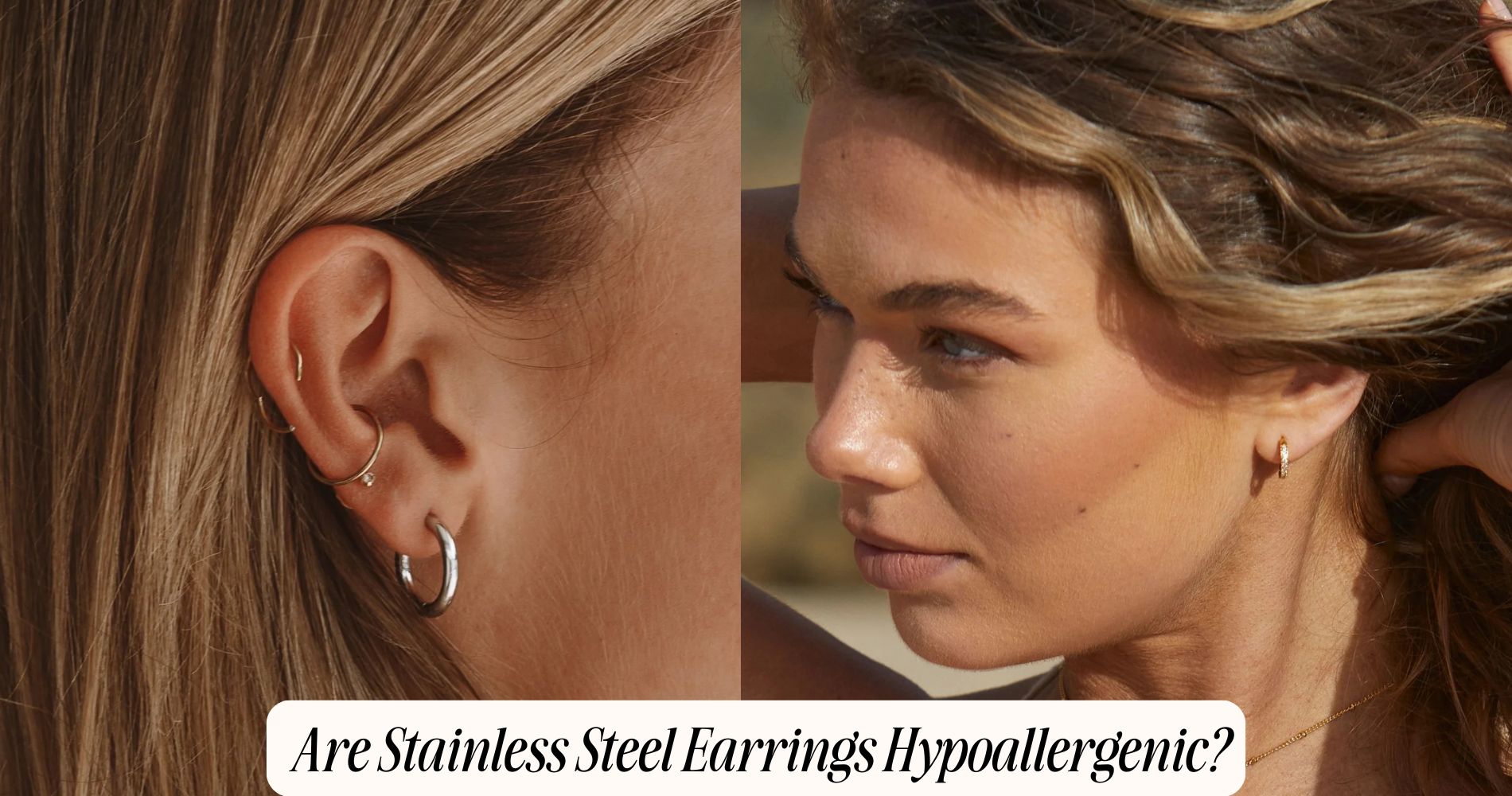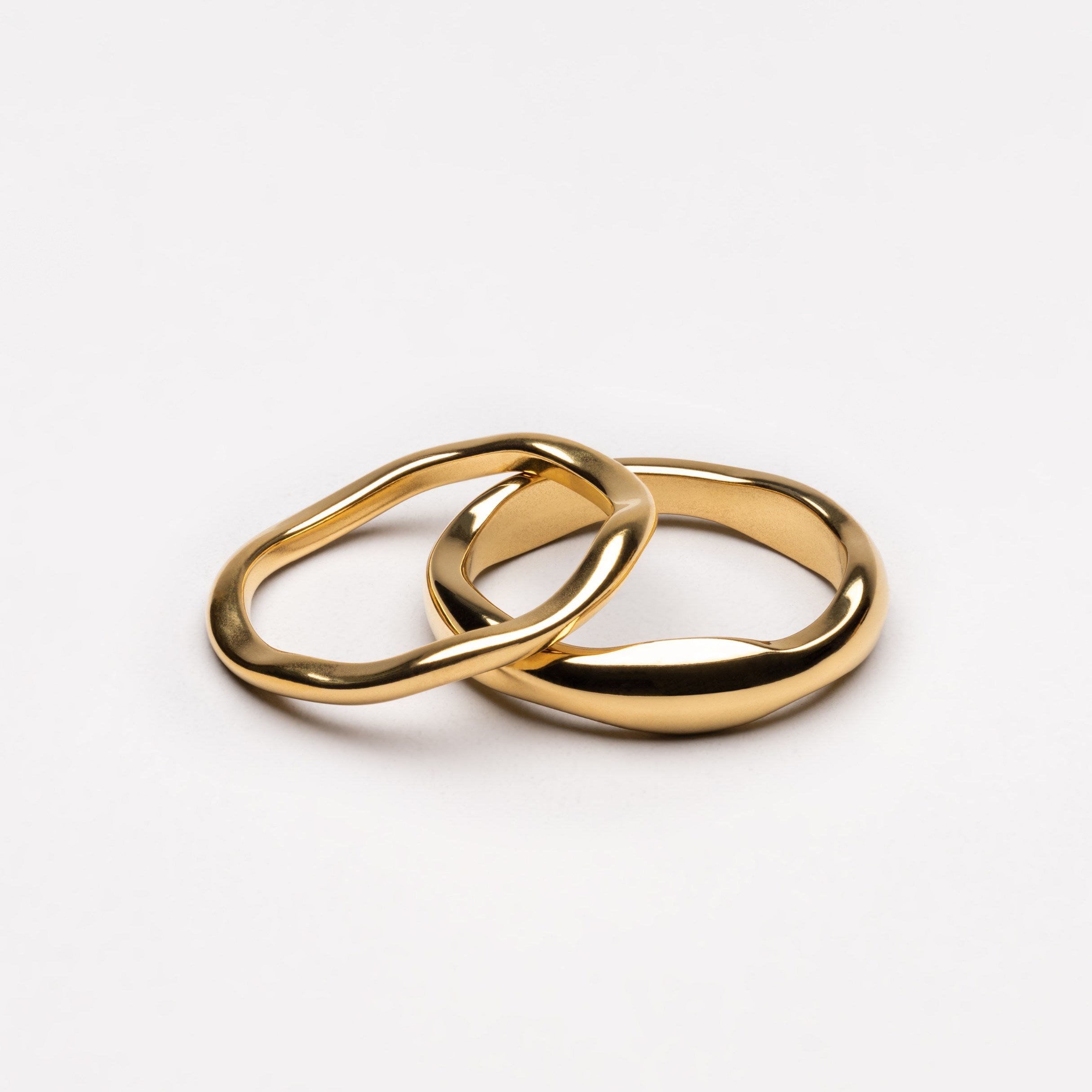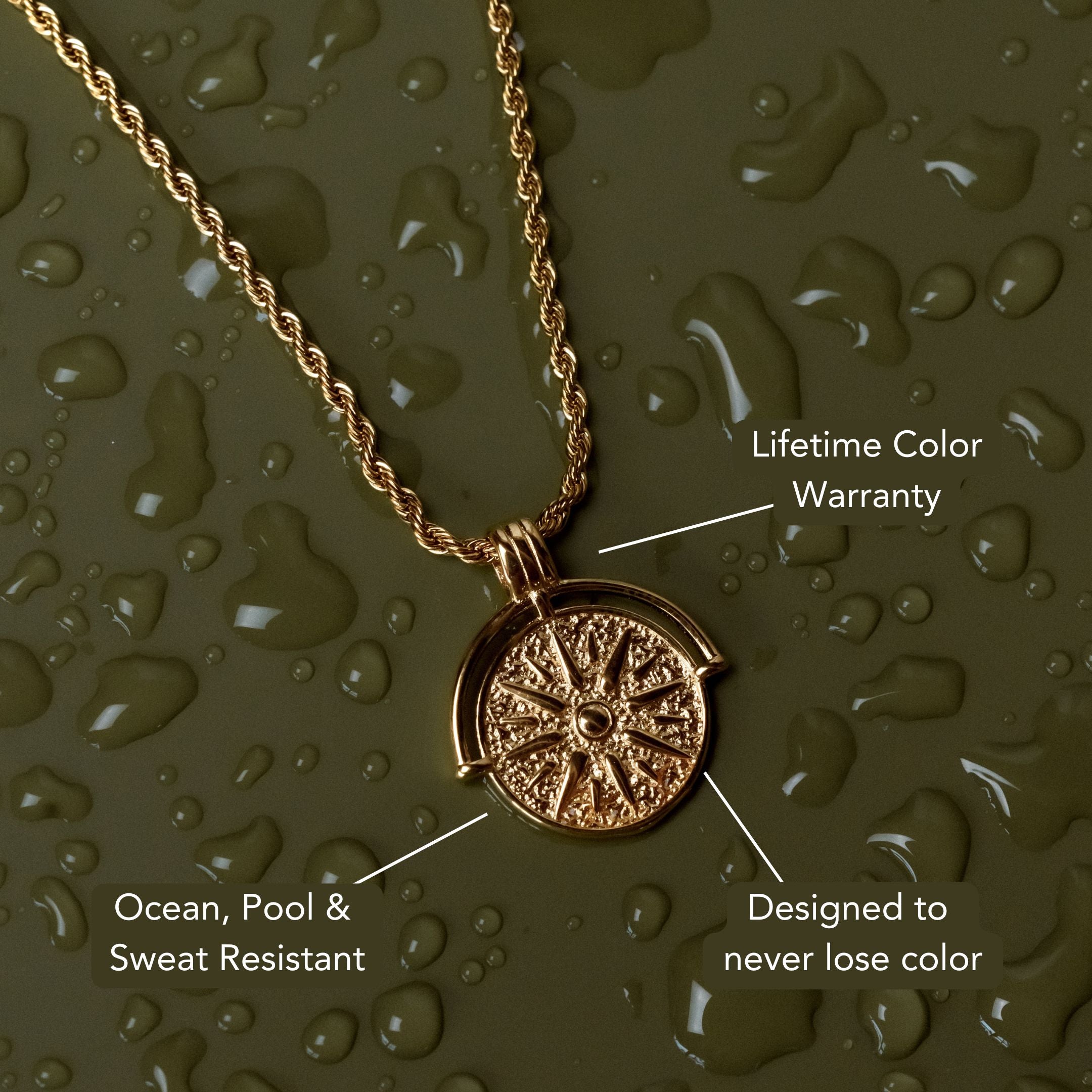
Are Stainless Steel Earrings Hypoallergenic?
Are stainless steel earrings hypoallergenic? Yes—especially when they’re made from medical-grade 316L or 304 stainless steel. These types are known for their tightly bonded nickel content, which releases very minimal allergens. That means they’re often well-tolerated by people with sensitive ears. However, those with severe nickel allergies might still experience a reaction. Choosing high-quality, unplated stainless steel helps minimize skin irritation while offering long-lasting durability. With the right care and smart selection, you can reduce allergy risks even more—explore our allergy-free earrings collection to find safe, stylish options.
Understanding Hypoallergenic Jewelry
Although jewelry can enhance personal style, it may also trigger adverse skin reactions in sensitive individuals. When you select hypoallergenic jewelry, you're choosing pieces specifically designed to minimize allergic responses.
Hypoallergenic properties refer to a material’s reduced likelihood of causing contact dermatitis or irritation. Research indicates that metals such as surgical stainless steel, titanium, and niobium exhibit higher hypoallergenic properties due to their low nickel release rates.
You should also factor in material durability—long-lasting metals resist corrosion and surface breakdown, decreasing the risk of allergen exposure over time. By opting for earrings with demonstrated hypoallergenic properties and robust material durability, you decrease the chance of developing skin complications.
This evidence-based approach allows you to wear jewelry confidently, even if you have sensitive skin.
Common Causes of Earring Allergies
When you experience an allergic reaction to earrings, it's most often due to your skin's sensitivity to specific metals, particularly nickel. Nickel sensitivity is the leading cause of contact dermatitis associated with jewelry.
If you have this allergy, your immune system identifies nickel ions as harmful, triggering an inflammatory response. Skin irritation, redness, itching, and swelling develop where your skin contacts the metal.
Even trace amounts of nickel in earring alloys can cause reactions in sensitized individuals. Other metals, such as cobalt and chromium, may also provoke allergic symptoms, but nickel remains the most significant culprit.
The likelihood and severity of skin irritation depend on both the metal content of the earrings and your individual threshold for sensitivity. Proper diagnosis involves patch testing by a medical professional.
What Is Stainless Steel?
Stainless steel is an alloy primarily composed of iron, with a minimum of 10.5% chromium by mass, which forms a passive layer that resists corrosion and oxidation. This chromium-rich layer is critical for preventing rust and ensuring longevity.
You’ll find that stainless steel includes other elements, such as nickel and molybdenum, to further enhance its mechanical and chemical properties. These additions contribute directly to material durability, making stainless steel highly resistant to everyday wear.
In the context of jewelry, stainless steel’s robust nature aligns with contemporary fashion trends, where both aesthetics and resilience are valued. Its ability to maintain a polished appearance under frequent use makes it a preferred choice for earrings and other accessories, ensuring both functional stability and lasting visual appeal.
Types of Stainless Steel Used in Earrings
Because not all stainless steels share the same composition, manufacturers use specific grades for earrings to balance durability, corrosion resistance, and hypoallergenic properties. The most prevalent types are 316L and 304 stainless steel.
You’ll find that 316L, often labeled as “surgical steel,” features a metal composition with higher molybdenum content, enhancing resistance to tarnish and oxidation. In contrast, 304 stainless steel has a slightly different alloy composition, providing sufficient strength and corrosion resistance for everyday wear.
During manufacturing processes, these steels undergo cold working and precise shaping to achieve a smooth, polished surface that minimizes skin irritation. By selecting these grades, manufacturers guarantee earrings maintain structural integrity and minimize the risk of adverse skin reactions, optimizing both safety and longevity for users.
Nickel Content in Stainless Steel
A key consideration in evaluating stainless steel earrings' hypoallergenic properties is their nickel content. Stainless steel is an alloy, meaning its composition includes several metals, often nickel.
You should know that nickel sensitivity is common, and even trace amounts can trigger allergic reactions in susceptible individuals. The alloy composition varies across different stainless steel grades. For example, 316L, known as surgical stainless steel, typically contains between 10-14% nickel by weight.
However, the nickel in high-quality stainless steel is tightly bound within the alloy matrix, which minimizes its direct release onto the skin. Despite this, if you have pronounced nickel sensitivity, even minimal exposure may result in dermatitis.
Consequently, always consider the specific alloy composition when selecting stainless steel earrings to minimize allergic risk.
Comparing Stainless Steel to Other Metals
While many metals appear suitable for earrings, their hypoallergenic properties differ markedly. If you have a metal allergy, it's crucial to assess the composition of jewelry materials before making a choice.
Stainless steel contains a stable alloy structure that generally reduces the risk of allergic reactions, especially when compared to nickel, a common sensitizer in earrings.
Gold, particularly 14k or lower, often contains nickel and may provoke reactions in sensitive individuals.
Silver, while less allergenic, can tarnish and introduce other metals during alloying, increasing risk.
Titanium and niobium are highly biocompatible, rarely causing metal allergy.
However, costume jewelry materials, such as plated metals, often lack consistent hypoallergenic properties due to mixed alloys.
Understanding these differences helps you make informed decisions about safe earring choices.
Benefits of Stainless Steel Earrings
Given the varying hypoallergenic properties of different metals, stainless steel stands out for its unique benefits in earring applications.
You’ll find that stainless steel offers high resistance to tarnish and corrosion, which guarantees longevity and maintains structural integrity. This metal’s nonporous surface minimizes bacterial accumulation, supporting hygienic use.
Its durability allows for intricate designs that align with evolving fashion trends, letting you express personal style without compromising safety. Stainless steel’s affordability and accessibility further increase its appeal across diverse demographics.
Additionally, this material holds cultural significance in various societies due to its association with modernity and resilience. Its neutral, polished appearance complements a range of skin tones and outfits, making it a versatile choice for many seeking both function and aesthetics in their accessories.
Potential Risks and Skin Reactions
Although stainless steel earrings generally exhibit low allergenic potential, certain alloys may contain trace amounts of nickel, chromium, or other metals that can provoke skin reactions in sensitive individuals.
If you have a hypersensitivity to these metals, you might experience localized redness, itching, or swelling, which are characteristic signs of allergic dermatitis.
Clinical studies indicate that nickel release from some stainless steel grades may contribute to adverse cutaneous responses.
In addition to allergic dermatitis, you may encounter piercing complications such as delayed healing, irritation, or even secondary infections if the skin barrier is compromised.
These risks increase with prolonged exposure or repeated contact.
Hence, it’s important to recognize that while stainless steel is generally safe, it’s not entirely risk-free for those prone to metal allergies or skin sensitivities.
Tips for Choosing Safe Earrings for Sensitive Ears
If you have sensitive ears, selecting safe earrings involves careful evaluation of material composition and manufacturing standards. Prioritize earrings labeled “nickel-free” or “hypoallergenic” to minimize risk, as nickel allergy is a common trigger for skin irritation.
Examine product descriptions and request documentation on alloy content, especially if you’re purchasing stainless steel jewelry. Medical-grade stainless steel, such as 316L or 304, is preferable since it contains reduced nickel content and follows stringent jewelry safety protocols.
Avoid plated or unknown alloy earrings, as thin coatings may wear off and expose underlying metals. Opt for earrings from reputable manufacturers that comply with jewelry safety regulations.
Caring for Your Stainless Steel Earrings
While stainless steel earrings offer excellent durability and resistance to tarnish, proper care is essential to maintain their hypoallergenic properties and appearance.
You should implement evidence-based jewelry cleaning methods: Clean your earrings regularly with mild soap and warm water, then dry them thoroughly to prevent moisture retention, which could promote bacterial growth or irritation.
Avoid harsh chemicals, as these may degrade the passive oxide layer that provides hypoallergenic protection.
For storage tips, keep your stainless steel earrings in a dry, separate compartment—ideally a soft-lined jewelry box—to minimize scratches and contact with other metals, which can cause surface damage.
Consistent care reduces the risk of contamination and preserves the integrity of the earrings.
Adhering to these guidelines ensures ongoing safety and ideal aesthetic quality.
Frequently Asked Questions
Can Stainless Steel Earrings Be Custom-Made for Unique Designs?
You can request stainless steel earrings in a custom design, utilizing various material options. Jewelers frequently employ precision tools to achieve unique patterns, ensuring structural integrity and aesthetic appeal, according to documented manufacturing techniques and industry standards.
Are Stainless Steel Earrings Safe to Wear While Swimming?
You can wear stainless steel earrings while swimming, as their corrosion resistance enhances swimming safety. Their hypoallergenic properties also reduce allergy risks. However, prolonged exposure to chlorinated or saltwater environments may cause gradual surface deterioration or irritation in sensitive individuals.
How Long Do Stainless Steel Earrings Typically Last?
Stainless steel earrings typically last several years, provided you practice proper jewelry care. Their durability resists corrosion and tarnish. If you have metal allergies, stainless steel’s composition reduces adverse reactions, further extending the earring’s lifespan.
Do Stainless Steel Earrings Tarnish Over Time?
Stainless steel earrings resist tarnishing due to their chromium content, which forms a protective oxide layer. You’ll find they rarely discolor. This minimizes allergy risks and skin reactions compared to other metals, according to clinical dermatology evidence.
Can Stainless Steel Earrings Be Recycled or Repurposed?
You can recycle stainless steel earrings through standard metal recycling options, as stainless steel is an eco friendly material. Evidence shows stainless steel retains its properties after melting, allowing efficient repurposing into new products without quality loss.
Conclusion
When choosing earrings for sensitive ears, stainless steel offers a generally hypoallergenic option due to its corrosion resistance and low allergen release. However, certain stainless steel grades contain nickel, which may still trigger reactions in highly sensitive individuals. Prioritize surgical or implant-grade stainless steel to minimize risk. Always monitor for irritation and consult a dermatologist if symptoms arise. Proper care and informed selection will help you enjoy the benefits of stainless steel earrings with reduced risk of allergic response.























Leave a comment
This site is protected by hCaptcha and the hCaptcha Privacy Policy and Terms of Service apply.